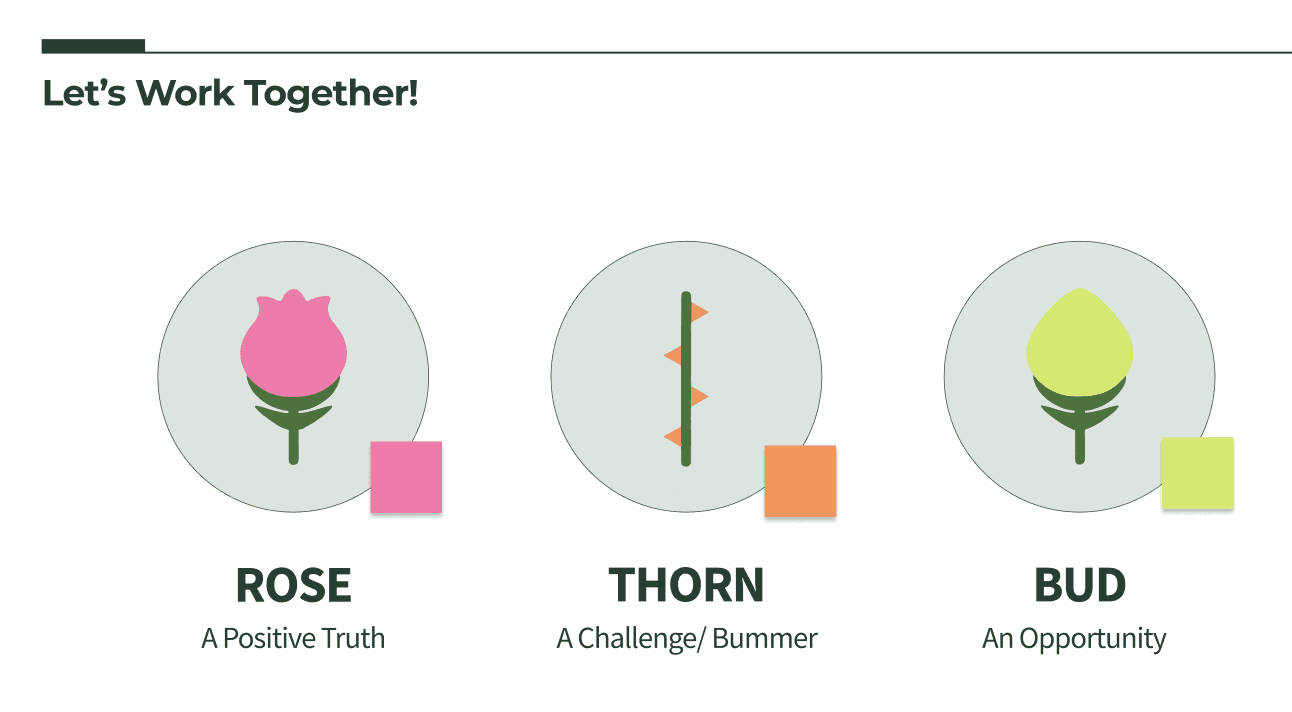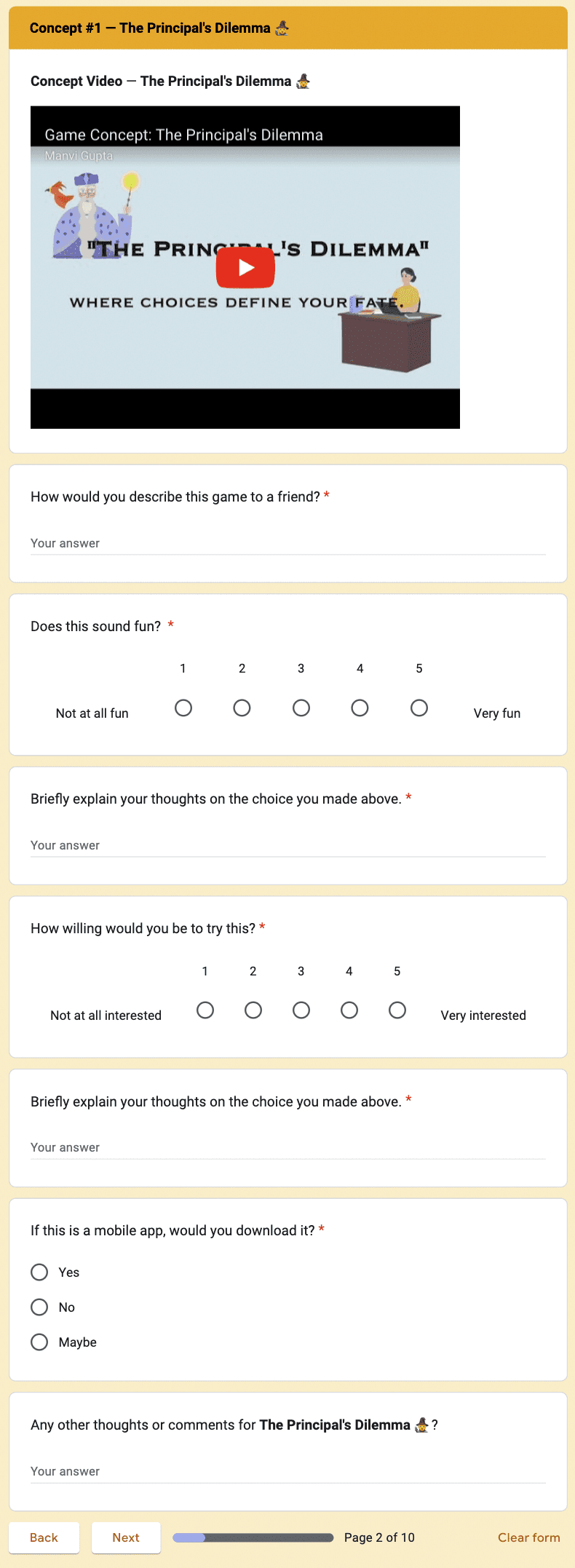


phase 2/3 | ideate
Clustered concepts
step 1
step 2

Internal critique


phase 1/3 | Research
Exploring the Problem Space
Many times, the issues clients bring to the UX research team aren't the core problem. Therefore, before diving into problem-solving, we thoroughly explore the problem space, identifying core pain points at system and stakeholder levels.
Even if our product doesn't address all these pain points during the design phase, such knowledge remains highly valuable.
Taking Form:
Games! Why Games?

Surprisingly, when we talk to with students regarding educational games explicitly, we received overwhelmingly negative feedback. It appears that there is a significant stigma attached to educational games, often seen as uncool or unappealing, especially when students are required to use an app as part of their coursework.
As captured in the following diagram, through internal
and external critiques, we ultimately went with the direction of communication-based sans-tech games.
The survey above received ~70 responses from
17-year-old US teenagers.
Among the 6 concepts we presented, the ones with no preset narratives, shorter gameplay, and opportunities for interaction with friends received the most positive reviews.
Thus, we focused on refining 'Terrible Workers' and how the game could be situated within a larger system to bring about a broader impact.


phase 3/3 | Refine & Deliver
Refine and Deliver
Terrible Workers adopts a sleek, contemporary, and sophisticated visual style that appeals to teenagers. Predominantly featuring black with vibrant accent colors and simple geometric shapes, it avoids being overly flashy, allowing players to focus on the gameplay rather than the cards themselves. This visual design sharply contrasts with traditional “school/education ascetics” but seamlessly fits in both classroom and home settings.
The fully printed rigid box enhances the game's visual appeal, imbuing it with a feeling of sophistication and immersion. Opening the box is like stepping into a world where students are encouraged to express themselves without fear of consequences.
The hand cards feature a matte lamination finish, while the job cards are treated with a glossy lamination, granting them eye-catching style that matches their purpose as prizes players strive for.
Seconday Research
As a repository of all research procedures, artifacts, outcomes, insights, concept models, and design opportunities, we have delivered a detailed research report.
Often, we tend to blame the primary stakeholders, the teachers and students, when we encounter issues in schools. However, research indicates that students' lack of motivation to improve interpersonal skills is a systemic issue.
Our culture, traditions, and regulations prioritize standardized test scores, influencing university admissions and funding allocation at both individual and institutional levels. This often leads school admins to prioritize programs for hard skill education rather than interpersonal skills.
At the school level, administrators do not teach directly, creating differences in perspective compared to teachers. Teachers must juggle demands from administrators, their teaching preferences, and students' progress and interests, resulting in busyness and exhaustion. As these issues cascade down to students, they accumulate and negatively impact their development. This raises concerns about the future of our nation and society. What will our tomorrow look like when students are “Bottom of the sewage”?
Key findings
Primary Research
co-designing
with clients
Throughout the entire project, we maintained close communication with clients to ensure our exploration aligns with their needs.

To swiftly gain insights into clients’ perspective on the problem space and tap into their knowledge, we often engaged clients in collaborative design activities such as Rose, Bud, Throne, and Affinity Diagramming.
These co-design sessions not only facilitated in-depth discussions but also fostered strong trust, contributing to the smooth progress of subsequent research with students, teachers and other school admins.


← Clustering Rose, Bud, Throne sticky notes
→ Presenting insights

net-working with
field experts
Staying in touch with field experts and seeking their feedback on our current progress was also a key factor in ensuring the success of
the project.
Such connections allowed us to keep our project consistently aligned with the forefront of the field.

School Environment
School Admin
Culture, Tradition, Regulations
Teachers
Students
Home
supervises
sets rules
,
Educates
Influences
“Bottom of the sewage”
Primary stakeholders
Secondary stakeholders
The Waterfall Model:
capturing the status quo of the education system
engaging users + putting ourselves
in the context


The insights and assumptions derived from each interview and activity session were comprehensively synthesized and used to guide subsequent research activities with users.
This ensured that each round of interviews provided us with a deeper and more accurate understanding of the problem space.
15
1-hr interview with teachers and students
76
Unmoderated
survey results
20
Observation Sessions

↑ Raw notes clustered into insights
↓ Class observation notes from one visit

Students gain more when they value the learning process over the end goal.
stakeholder level
*Refer to research evidence on pages 63-82 of the report pdf*

Teachers care about student success but need support and safe spaces to try new techniques.
stakeholder level

Social cues further demotivate “low-performing” students, leading them to become apathetic.
system level

Federal regulations and the school environment strongly encourage a grade-focused mindset that is difficult to change.
system level
High level takeaways
Before talking about what succeeded, let’s see what had failed
Summary of takeaways

I want to help kids the best I can. But how?
Teachers

I need to get A for all classes and get into a good college.
Student:
Over-achievers
3 User Archetypes
our design should help them...
Student:
Misunderstood

School isn’t for me. Why would I try?

Ideating
step o
One game
Sitting/Duration
A
B
Purpose
Story
Lots of minigames
Purpose explicit
Not narrative driven
Purpose hidden
Narrative driven

goal setting
direction 3

progress Visualization
direction 2

reflection
direction 1
Such testing outcome sparked the idea of crafting gamified experiences.
But what sort of games speak best to teens while best fulfilling the educational purpose?
Style explorations
Final product


Concept video for a selection-based digital game
step 4
Concept video for communication-based analog game



step 3


Top voted concept from the cluster
Top voted concept from the cluster
step 5
External critique
(unmoderated survey, 6 concepts)













(Educational game) is something your mom makes you play...
— Student @ guerrilla interview
Asset developemnt


literature review & competitive analysis
Alongside studying the effectiveness of existing private and public high school programs directly related to high school soft skill education, we also explored analogous domains, such as behavior formation in psychology, and how these concepts are applied in fitness and language learning apps.
